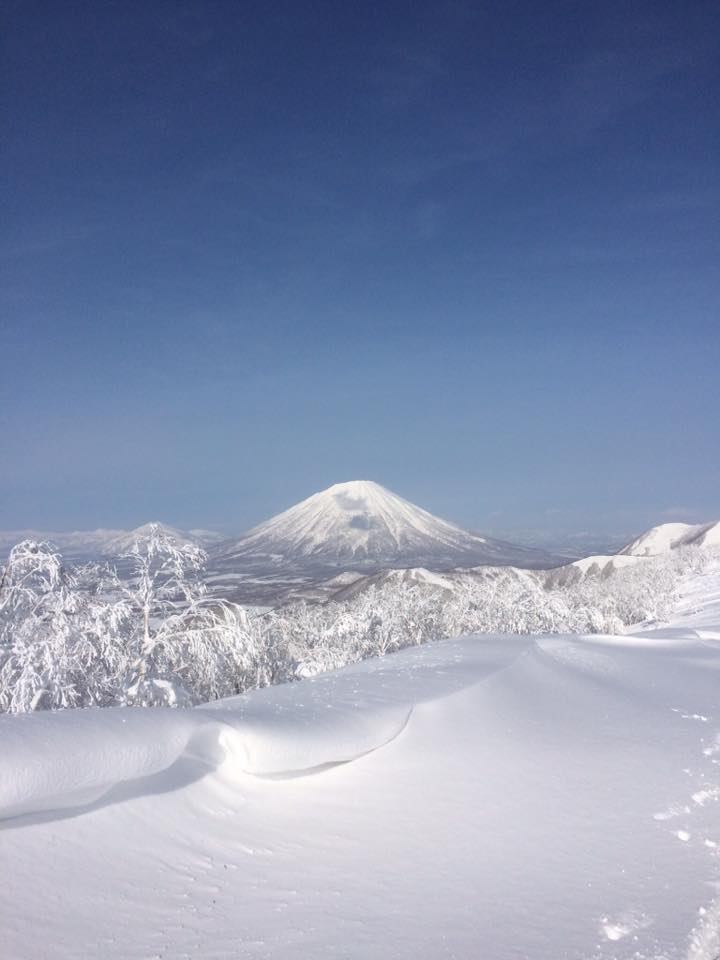
The view of active volcano Mt. Yotei from Rusutsu’s Mt. Isola. Bluebird views in Hokkaido are pretty unique in the skiing world. The mountains around here are pretty tasty too.
Here’s a resort guide for Hokkaido. If you want a general overview of what to expect from skiing in Japan, check here.
Hokkaido is the most northerly of Japan’s four main islands. It’s about the same size in area as Ireland, with less than half the population. As it’s further north and so close to Siberia, it also generally gets more snow, though individual winters can vary. Hokkaido is Japan’s last frontier, and also worth visiting in summer if you’re looking for the great outdoors in Japan (the rest of the country is very heavily urbanised and it can be difficult to really get away from the feeling that everywhere is developed.
Hokkaido’s main city is Sapporo, home of the famous beer, and the less-famous but still quite renowned Ice Sculpture Festival which is held every year in early February. The island is also home to Japan’s most popular ski area Niseko, as well as quite a few others ones.
Niseko
This is one of the largest ski areas in Japan, and probably the most popular with overseas tourists. It’s made up of four separate resorts, all accessible with one (Niseko United) pass, or individually. It’s popular for a reason, as it probably has the most of everything you’d want in one area in Japan – powder, (legal) backcountry access, trees, night-skiing, crowds, English speaking. It’s so popular with Australians and other overseas visitors though it doesn’t feel like you’re in Japan at all – not a problem finding a burger and some English-speaking service, but don’t expect much in the way of culture. It’s also very crowded (though probably less so than any large ski area in Europe) and expensive.
Go to Niseko if you want: a big ski area, freeriding, trees, night skiing, nightlife crowds, don’t particularly care about Japanese culture, love Aussie culture, cost isn’t an issue.
Rusutsu
Rusutsu is a small village about an hour from Niseko. There isn’t much to the village apart from a couple of five-star hotels and the ski resort itself. Many say the tree skiing here is the best in Hokkaido, though (I concur that it’s amazing). There are also none of the crowds you’ll find in Niseko.
There’s barely a town in Rusutsu, so nightlife is practically non-existent, and even meal options aren’t particularly extensive outside of the hotels (there are a couple of five-star hotels either side of the resort area. However, if it’s snowing and you’ve got a few days to spare it’s worth coming here for the tree skiing alone. There are also some really nice groomed pistes for drier days.
Go to Rusutsu if you want: tree-skiing, some peace and quiet, not interested in spending your all time in Japan surrounded by Australians
Furano
Like Rusutsu, this is a smaller area. It’s located in central Hokkaido the far side of Sapporo from Niseko and Rusutsu, and apparently this means even more snow falls here. There’s great freeriding here, even though technically you’re not allowed to ride it outside of marked areas. Many places in Japan enforce this policy, and they can – and do – take passes off offenders if they’re caught. Be warned.
Furano is also a famous summer holiday destination amongst Japanese, and is well-known for its lavender farms. As such there’s more of a town here than in, say, Rusutsu, and unlike Niseko, it’s a Japanese town at that.
Go to Furano if you want: pistes, less crowds, free-riding, Japanese culture
Conclusion
Visit all of them. Renting a car in Japan is easy, and a lot of people spend a day or two in one area before moving onto the next in a rental car. Mountains and ski areas in Japan aren’t as big as elsewhere around the globe, and so it’s possible to ‘run out’ of runs and new areas to explore over the course of a full week.
The landscape of Hokkaido is incredible, and somewhere I’ve been advised to revisit in summer. It’s quite a flat place (or it is near Niseko and Rusutsu anyway), with various volcanoes and ski hills protruding from flat farmland and sparsely dotted with leafless deciduous trees during winter. The backdrops you get while skiing are stunning and quite unique. Mt. Yotei (pictured above) is also an impressive-looking active volcano looming over Niseko and Rusutsu (and yes, it’s possible to snowboard down it if you know what you’re doing – i.e. have a splitboard/a guide).